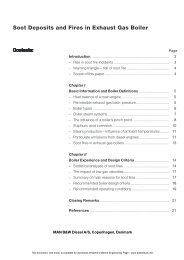Fuel Cells - Green Power - Martin's Marine Engineering Page
Fuel Cells - Green Power - Martin's Marine Engineering Page
Fuel Cells - Green Power - Martin's Marine Engineering Page
- No tags were found...
You also want an ePaper? Increase the reach of your titles
YUMPU automatically turns print PDFs into web optimized ePapers that Google loves.
Why a <strong>Fuel</strong> Cell Goes “Platinum”The half reactions occurring at each electrode can only occur at ahigh rate at the surface of the Pt catalyst. Platinum is uniquebecause it is sufficiently reactive in bonding H and O intermediates asrequired to facilitate the electrode processes, and also capable ofeffectively releasing the intermediate to form the final product. Forexample, the anode process requires Pt sites to bond H atoms whenthe H 2 molecule reacts, and these Pt sites next release the H atoms,as H + + e -H 2 + 2Pt ➔ 2 Pt-H2 Pt – H ➔ 2 Pt + 2 H + + 2e -This requires optimized bonding to H atoms — not too weak and nottoo strong — and this is the unique feature of a good catalyst. Realizingthat the best catalyst for the polymer electrolyte membrane fuelcell is expensive, lowering Pt catalyst levels is an on-going effort.One of the best ways to accomplish this is to construct the catalystlayer with the highest possible surface area. Each electrode consistsof porous carbon (C) to which very small Pt particles are bonded. Theelectrode is somewhat porous so that the gases can diffuse througheach electrode to reach the catalyst. Both Pt and C conduct electronswell, so electrons are able to move freely through the electrode. Thesmall size of the Pt particles, about 2 nanometers in diameter, resultsin an enormously large total surface area of Pt that is accessible togas molecules. The total surface presented by this huge number ofsmall particles is very large even when the total mass of Pt used issmall. This large Pt surface area allows the electrode reactions toproceed at many Pt surface sites simultaneously. This high dispersionof the catalyst is one key to generating significant electron flow, i.e.current, in a fuel cell.PolymerElectrolyteMembranePathway(s) allowingconduction of hydrogen ionsPathway(s) allowingconduction of electronsPathway(s) allowingaccess of gas tocatalyst surfaceCarbonPlatinumPolymer electrolyte membrane with porous electrodes thatare composed of platinum particles uniformly supportedon carbon particles.Water and <strong>Fuel</strong> Cell Performance“Water management” is key to effective operation of apolymer electrolyte membrane fuel cell. Although wateris a product of the fuel cell reaction, and is carried out of the cellduring its operation, it is interesting that both the fuel and airentering the fuel cell must still be humidified. This additional waterkeeps the polymer electrolyte membrane hydrated. The humidityof the gases must be carefully controlled. Too little water preventsthe membrane from conducting the H + ions well and the cellcurrent drops.If the air flow past the cathode is too slow, the air can’t carry allthe water produced at the cathode out of the fuel cell, and thecathode “floods.” Cell performance is hurt because not enoughoxygen is able to penetrate the excess liquid water to reach thecathode catalyst sites.Future Opportunities• Impurities often present in the H 2 fuelfeed stream bind to the Pt catalystsurface in the anode, preventing H 2oxidation by blocking Pt catalyst sites.Alternative catalysts which can oxidizeH 2 while remaining unaffected byimpurities are needed to improve cellperformance.• The rate of the oxygen reductionprocess at the air electrode is quite loweven at the best Pt catalysts developedto date, resulting in significantperformance loss. Alternative catalyststhat promote a high rate of oxygenreduction are needed to further enhancefuel cell performance.• Future alternative catalysts must be lessexpensive than Pt to lower the cost ofthe cell.This document, and more, is available for download at <strong>Martin's</strong> <strong>Marine</strong> <strong>Engineering</strong> <strong>Page</strong> - www.dieselduck.net9

















